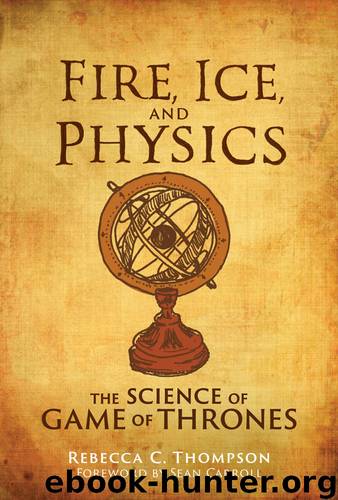Fire, Ice, and Physics by Rebecca C. Thompson

Author:Rebecca C. Thompson
Language: eng
Format: epub
Publisher: MIT Press
Finally, Dragons
Now, what about dragons? Thanks for bearing with me through long explanations of flight in everything but dragons. It’s important, however, to understand how both animals and 747s fly to understand how an animal the size of a 747 can fly. When thinking about fantasy animals such as dragons, it’s usually a good idea to think to yourself, “If this animal is so cool, why didn’t nature think of it first?” That’s a good place to start when it comes to dragons. Why don’t we have huge flighted animals? Can’t we just scale up a bat—both in size and, well, actual scales—and say it works? The reason it’s impossible to simply scale up flighted animals is because weight increases as volume and wing size increase, but the ability to create lift increases with area. Doubling the size of a bat would result in an eightfold increase in weight but only a fourfold increase in the area of the wings. This leads to a lot of interesting problems. Would it be possible for an animal to overcome these physical limitations and become a huge airborne flamethrower?
Let’s start with what we know. According to GRRM, Drogon has a 20-foot wingspan when he enters the fighting pits. If we assume they have the same aspect ratio (ratio of wing length to width) as bats,10 this would mean his wing area is about 15 m2. In the TV show, he looked to be about the size of an elephant, so let’s assume he has a weight of 13,000 pounds. This means he would need 57,900 N of lift to stay off the ground. Though the lift coefficient changes continually during a wing flap, we can estimate an average of about 2.11 This might be a bit too conservative of an estimate because bats are extremely adept at changing their wing shape to create lift, but it’s a good starting point for doing the math. Plugging these values into the lift equation, this means that Drogon would need to maintain a speed of about 125 mph to cruise without the added lift from flapping. With the additional lift, he could go even slower and be fine. Considering bald eagles can create enough thrust to glide at about 95 mph, Drogon should have no problem staying aloft with his wing beats. Dragons probably have huge lungs because they need lots of air to breathe fire, so it’s possible they weigh considerably less than an elephant, but I don’t have a good way to estimate the lung size, and therefore weight, of a dragon. I’ll go into possibilities in the next chapter, but for this estimate it’s best to just assume the weight of an elephant.
Seeing as Drogon can breathe fire, he has another built-in mechanism for generating lift—his wings don’t have to do it all. When Drogon sets things on fire, he creates heat, and hot air rises. If Drogon can strategically set things on fire, then he doesn’t have to eat so many sheep because he won’t need to expend as much energy to create lift.
Download
This site does not store any files on its server. We only index and link to content provided by other sites. Please contact the content providers to delete copyright contents if any and email us, we'll remove relevant links or contents immediately.
The Complete Stick Figure Physics Tutorials by Allen Sarah(7307)
Secrets of Antigravity Propulsion: Tesla, UFOs, and Classified Aerospace Technology by Ph.D. Paul A. Laviolette(5309)
Thing Explainer by Randall Munroe(3877)
The River of Consciousness by Oliver Sacks(3541)
The Order of Time by Carlo Rovelli(3145)
How To by Randall Munroe(3035)
A Brief History of Time by Stephen Hawking(2962)
I Live in the Future & Here's How It Works by Nick Bilton(2935)
The Great Unknown by Marcus du Sautoy(2648)
What If?: Serious Scientific Answers to Absurd Hypothetical Questions by Randall Munroe(2637)
Midnight in Chernobyl by Adam Higginbotham(2483)
Blockchain: Ultimate Step By Step Guide To Understanding Blockchain Technology, Bitcoin Creation, and the future of Money (Novice to Expert) by Keizer Söze(2449)
Networks: An Introduction by Newman Mark(2360)
The Meaning of it All by Richard Feynman(2300)
Easy Electronics by Charles Platt(2282)
The Tao of Physics by Fritjof Capra(2231)
Midnight in Chernobyl: The Untold Story of the World's Greatest Nuclear Disaster by Adam Higginbotham(2177)
When by Daniel H Pink(2083)
Introducing Relativity by Bruce Bassett(2080)
